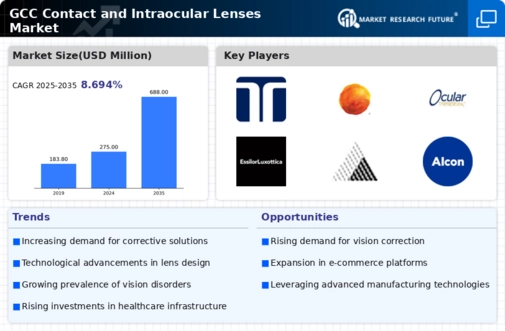Market Growth Projections
The Global GCC Contact and Intraocular Lenses Market Industry is projected to experience robust growth, with estimates indicating a market value of 25.5 USD Billion in 2024 and a potential increase to 45 USD Billion by 2035. This growth trajectory suggests a compound annual growth rate of 5.3% from 2025 to 2035, reflecting the industry's adaptability and responsiveness to consumer needs. The expansion is likely driven by various factors, including technological advancements, increasing awareness of eye health, and demographic shifts. These projections highlight the dynamic nature of the market and its potential for future development.
Expansion of Distribution Channels
The expansion of distribution channels, including online platforms and retail outlets, is facilitating access to contact and intraocular lenses, thereby driving the Global GCC Contact and Intraocular Lenses Market Industry. E-commerce has emerged as a convenient option for consumers, allowing them to purchase lenses with ease. This accessibility is particularly important in regions where traditional retail options may be limited. As the market adapts to these changes, it is expected to see substantial growth, with an anticipated market value of 45 USD Billion by 2035. This trend underscores the importance of distribution strategies in meeting consumer demand.
Increasing Awareness of Eye Health
There is a growing awareness of eye health and the importance of regular eye examinations, which serves as a significant driver for the Global GCC Contact and Intraocular Lenses Market Industry. Educational campaigns and initiatives by health organizations are encouraging individuals to prioritize their vision care. This heightened awareness is likely to lead to increased demand for both contact lenses and intraocular lenses, as more people seek corrective solutions. As the market evolves, this trend could contribute to a compound annual growth rate of 5.3% from 2025 to 2035, reflecting the industry's responsiveness to consumer needs and health trends.
Demographic Shifts and Urbanization
Demographic shifts, particularly urbanization and an aging population, are influencing the Global GCC Contact and Intraocular Lenses Market Industry. As more individuals move to urban areas, lifestyle changes often lead to increased screen time and subsequent vision issues. Additionally, the aging population is more susceptible to conditions requiring corrective lenses. These factors are likely to drive demand for both contact and intraocular lenses, contributing to a projected market growth to 25.5 USD Billion in 2024. The interplay of these demographic trends suggests a sustained demand for vision correction solutions in the coming years.
Rising Prevalence of Vision Disorders
The increasing prevalence of vision disorders, particularly myopia and presbyopia, is a primary driver for the Global GCC Contact and Intraocular Lenses Market Industry. As populations age and lifestyle factors contribute to eye health issues, the demand for corrective lenses is expected to rise significantly. In 2024, the market is projected to reach 25.5 USD Billion, reflecting a growing recognition of the need for effective vision correction solutions. This trend is likely to continue, with the market expanding as more individuals seek interventions for their visual impairments, thereby enhancing the overall growth trajectory of the industry.
Technological Advancements in Lens Design
Technological advancements in lens design and materials are transforming the Global GCC Contact and Intraocular Lenses Market Industry. Innovations such as silicone hydrogel materials and advanced multifocal designs are enhancing comfort and visual acuity for users. These developments not only improve the user experience but also expand the range of options available to consumers. As a result, the market is poised for growth, with projections indicating a rise to 45 USD Billion by 2035. The integration of smart technology into lenses may further drive this trend, appealing to tech-savvy consumers and potentially reshaping the market landscape.


















Leave a Comment